What toys should not get graded by the AFA/CGA, CAS, etc?
For decades, services like the AFA (Action Figure Authority), which is a part of the CGA (Collectible Grading Authority), and the CAS (Collector’s Archives Services) have helped to preserve toys from the past. These services have set a standard metric that measures the mint state of toys and other collectibles. So, collectors no longer rely on what the seller said the condition was, instead, they could trust the impartial grading system.
These services have also played a crucial role in preserving these toys from the past. Beyond cementing the mint grading for these toys, they also encase collectibles in protective cases that keep them safe from damage. While these cases do not prevent all sources of deterioration, they help keep them safe from environmental dangers like dust and sunlight.
Thus, it is no surprise that graded toys command a premium price in the market. Likewise, many collectors who have mint, sealed toys consider sending them to one of the several grading services like the AFA/CGA or CAS. Still, not every vintage toy should be professionally graded, for not all sealed toys are equally valuable. Moreover, there are risks to sending valuable collectibles to these services. You may even find that you will prefer an alternative option, like clamshell or sliding cases, which will be discussed in full later.
Why do collectors love grading services like the AFA/CGA and CAS?

In the past, dealers and resellers judged toys and collectibles and decided which were in mint condition. However, there was no set standard to judge these products. Each store, dealer, or individual could claim any sealed product was mint. Some even added additional descriptors to subjectively indicate that the items were even better quality. Thus, there was no universal standard to judge the products on.
When the Action Figure Authority was formed, they set out to create a standard scale to judge all other action figures. Thus, collectors no longer had to figure out the quality of their products on their own. To achieve this, they decided to judge action figures based on three main criteria: the condition of the figure itself, the condition of the box or card, and the condition of the window or blister. Each separate segment received a grade from 1-100, with the 80s being average mint and the 90s being superb and near pristine.

Thanks to these grades, no one had to second guess the quality of the mint toy that they were receiving. Moreover, the toys from these grading services were preserved in protective acrylic cases. So, there was less chance of the products being damaged by the home environment. As the trust in the grades increased, the value of the toys also rose. So, many desire to grade their mint-condition toys.
Before you consider sending your toys to be graded
While it is understandable to want to make the most out of a vintage toy collection, it is not always the best decision. There are many hurdles and elements about services like the AFA/CGA that collectors should be aware of before deciding to get their toys graded.
First and foremost, none of these services are cheap. In fact, all of them have additional fees and optional services to entice collectors to spend more with them. While it is possible to pay the lowest price for the smallest figures at less than $50, it would take months before the figure is returned. Meanwhile, it is possible to pay a premium, usually around $100, to expedite the process. Even though this investment is worthwhile for certain toys, it is not a sound choice for the mass majority.
Moreover, before a toy is sent to these services, the owner must fill out their submission forms. Even though they offer FAQs to help guide customers through the submission process, it is still lengthy and somewhat confusing. Thus, it would not be possible to just ship off toys to these services. As mentioned earlier, these forms include multiple extra services which are optional and usually unnecessary. Still, the terminology and length of these forms can cause confusion for those new to grading toys.
Not every toy should be sent in to receive a grade
As the popularity of the AFA and other grading services rose, many collectors began to believe that any toy with a grade would become a valuable investment. Unfortunately, this is far from the truth. Many collectors that send toys to these services for grades never see a return on investment. Worse yet, some discover that their toy lost value due to damage in shipping. Luckily, there are simple ways to check which toys should get graded before sending them in.
Large toys and collectibles are at serious risk
If you have a collection that includes large toys, like a Transformers G1 Scorponok, a Kenner Star Wars Imperial Shuttle, or a G.I. Joe Defiant, you should consider not sending in your larger toys for grades. Large products such as these are at serious risk to receive damage in shipping. Even though most postal services like FedEx, UPS, and USPS offer shipping insurance, they provide no guarantee that they will not receive damage during shipping. Even the tightest and most careful packaging does little to protect a product from mishandling.
More importantly, the acrylic cases for these size toys are not as effective as smaller acrylic cases. It is not uncommon to find a cracked case on toys larger than the G1 Transformers giftsets. For instance, the last two graded G1 Superion sets that we received had cracked cases. Even if the toy survived its shipment to the grading service unscathed, it may not return unscathed.
So, it is not a practical use of funds to send in a large toy for a professional grade. Other methods can be used to preserve the quality of these toys which will be discussed later.
Some toy lines have known problems that can make them less suitable for grading
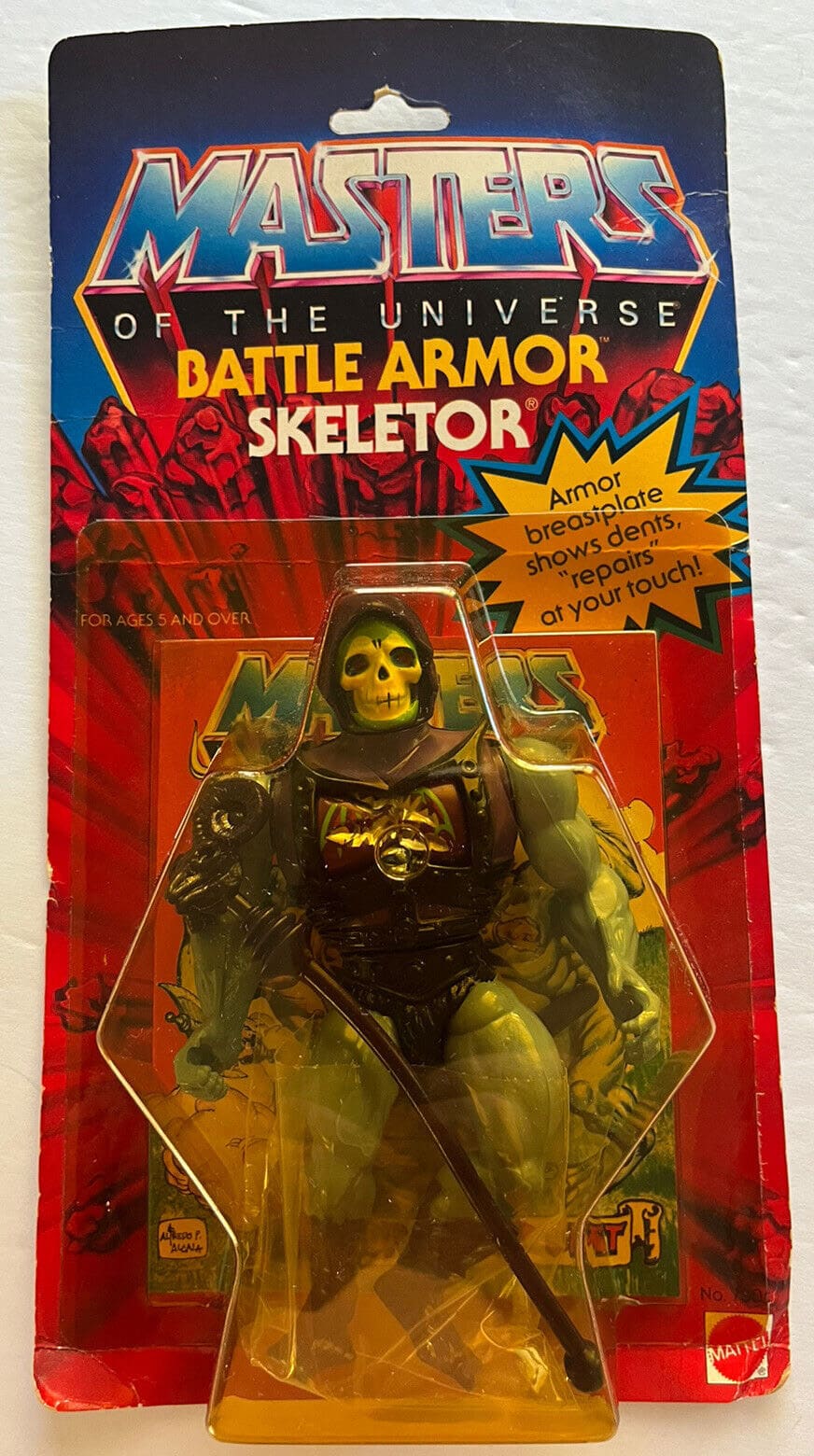
Even though mint, unopened toys from the 70s and 80s are rare and sought after, not every toy line has survived the decades intact. Over the years, some collectors and fans have seen toy lines that have built-in issues that make them poorer. For instance, the Magnum P.I., The Fall Guy, Micronauts, and others have O-rings that fail and cause the figures to fall apart. Other notable toy lines include many Remco toy lines, Mego toys like the Black Hole, ERTL toys, ChiPs, Buck Rodgers, and many more.
There are also very popular toy lines that contain O-rings and leg bands that could potentially lead to the figure falling apart. For instance, G.I. Joe toys have these O-Rings. Meanwhile, Mattel used leg bands in their He-Man toys that fail to survive the passage of time. No matter how pristine one of these toys may be at the moment, they are always at risk to fail. So, even though there is a market for these toys with AFA grade, collectors need to be careful.
For the most part, you should avoid submitting loose figures with known issues for a professional grade. Buyers trust the quality of a loose figure with known issues less than a sealed one. As even sealed toys may have these issues, you should be cautious and closely examine your unopened figures for signs of damage. Notably, these toys can fail even after grading.
Some collectors have even removed these toy lines from their collections because of these known issues. We have even specifically purchased collections from people who would rather sell their toys than have a professionally graded one that has a problem that can present itself in a few years.
If your toy is not old enough, it will not command a price to offset your expenses
Even though we are well into the 2020s, not every toy has reached the point to become valuable vintage collectibles. So, even though collectors may have pristine toys from the early 2000s and even the 1990s, they will often not gain enough extra value. While this is partially because the toys are not old enough, it is also true that the generation with the buying power is mostly over forty years old. Thus, the toys from their childhoods, from the late 1970s to the 1980s, are the ones that are in demand. This problem is further compounded by the ready supply of toys from the 1990s and later.
While a toy from the first Generation of Transformers and G.I. Joe A Real American Hero make great candidates for grading, Beast Wars and other toys from the 1990s generally do not. Overall, any collector should consider the return on investment before sending toys to grading services.
Even if your toys are old enough, they still require interest from collectors
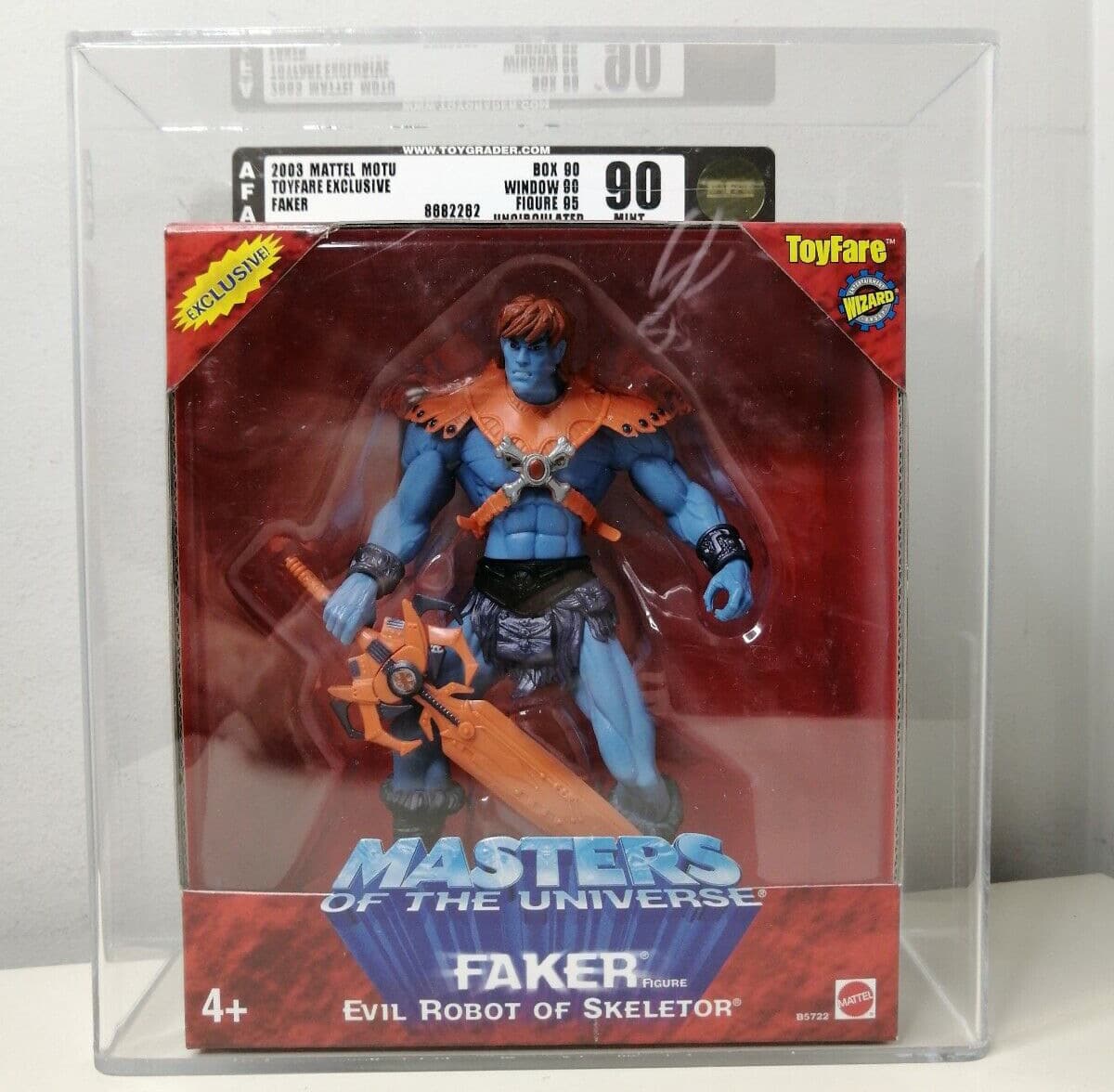
While it is true that most toys from the 1970s and 1980s gain the greatest benefit from a professional grade, not every toy line enjoys these benefits. There have been toy lines like Gabriel’s Legend of the Lone Ranger, which has popped up as graded toys on eBay. Even though these toys were from the 1980s, sealed figures, like Scout with an 85 grade, only managed to sell for $250. Most other figures from this line even sold for less. So, this toy line is a poor candidate for grading.
Overall, it is not easy to find the perfect toy that will gain a tremendous boost in price to make the expense with the AFA/CGA, CAS, or other services worth it. Any collector considering these services should carefully examine the going prices of these toys and the community support.
Some Loose Figures are not good candidates for grading
Even though grading services like the AFA/CGA and CAS offer services for grading loose figures, especially for the mail-in toys that never hit store shelves, collectors should think twice. For the most part, loose figures are not a good candidate for grading. Buyers do not value nor trust the loose figures as much as the boxed figures. Since these figures are loose, they had more opportunity to be exposed to the elements, which damage toys over time. So, many loose figures are prone to falling apart thanks to issues like failing O-rings and leg bands. Moreover, these figures do not have boxes to offset any defects in the toy itself.
Additionally, some loose toys have such unique designs that they become problematic to properly case. While the AFA/CGA, CAS, or other grading services will do their best to case these figures, there are no guarantees. Some of these loose figures will never fully remain secure and stable in the case, so they become risky to ship. Otherwise, the case may be designed to secure the figure but negatively impact the presentation and obscure the toy.
Do not send in a damaged toy for professional grading
Collectors who prepare their toys to be sent to a grading service should take time to closely evaluate the toy for themselves. As a rule of thumb, owners should examine their toys for noticeable scuffs, dings, and other signs of obvious damage. There are an array of criteria that the AFA/CGA, CAS, and other services use to judge the quality of these figures, so let us break them down.
The Box or Card
First, the package that the figure came in is very important. Most grading services have a category set aside solely for the package. So, this part of the toy requires careful examination.
While there are obvious forms of damage, like ripped and torn cardboard, there is more to consider. First and foremost, if the tape has ever been broken, dried out, became loose, or failed, the toy might not be a good candidate for grading. In the past, services like the AFA are known to reject a toy simply because they believe that it has been opened previously. They also reject double-taping and other restoration techniques. Unfortunately, a toy can be rejected even if the double taping had been applied by the factory.
While they reject opened toys from the standard tiers, there is an option for opened products to receive a professional grade. If the toy has all of the paperwork, accessories, and all other elements, it will receive a “Q” or “Qualified” grade. So, there is a potential to grade an open-boxed figure. Keep in mind that qualified grades are not as prestigious as a mint-in-box grade and are significantly lower.
Owners should also check the box or card for damage that may occur from storage or display. Dust is damaging to boxes as well as it is to action figures and other painted collectibles. Similarly, sunlight, heat, moisture, and many other environmental hazards have the potential to severely damage the packaging. So, if the toy’s packaging has stains, tears, dings, faded graphics, or is otherwise not pristine, do not send it to a grading service.
The Window or Bister
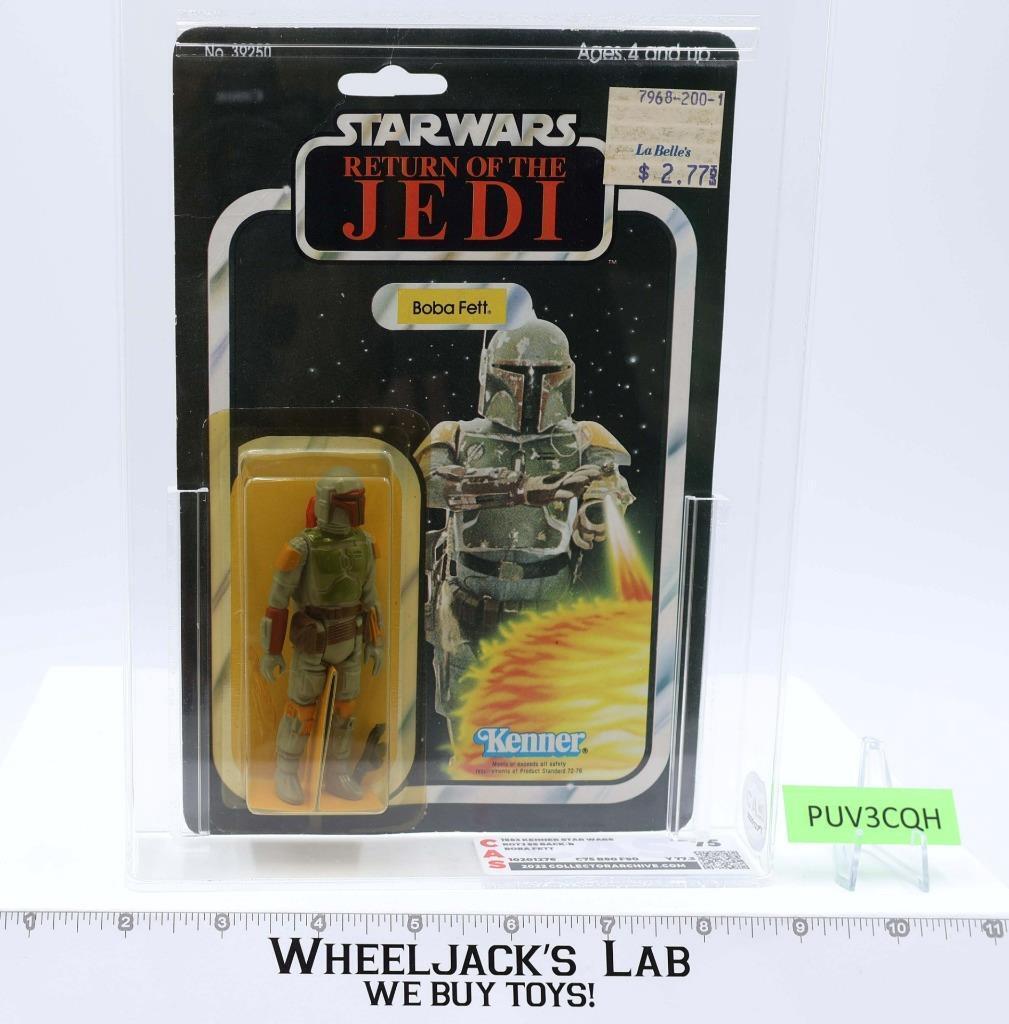
The next category that requires close inspection is the plastic window or blister, the plastic that covers carded toys. The AFA/CGA has a separate category for this part of the toys, as do many other services. So, it is crucial to closely examine the plastic.
One of the most obvious issues that will instantly devalue a vintage toy is yellowed windows or blisters. This is a common occurrence that plastic will suffer from, especially if it has been exposed to sunlight. Beyond staining the plastic with yellow discoloration, this deterioration is even more destructive. The plastic becomes brittle as the yellowing worsens. So, it is not uncommon for a yellowed window or blister to also be cracked, punctured, or otherwise damaged.
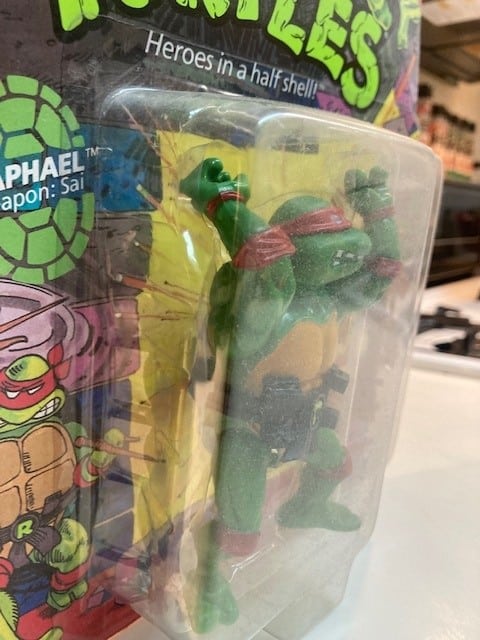
Owners also need to check the plastic for scratches, dings, scuffs, and other surface damage. While obvious cracks and punctures are easy to recognize as disqualifications, the smaller damage will also lower the potential grade. Remember that the target score for a graded toy is 85 and above. So, even small scruffs matter. Unfortunately, not even a toy that is bought straight off a toy shelf is safe from scratches and scruffs since most of this damage occurs during transit to the store.
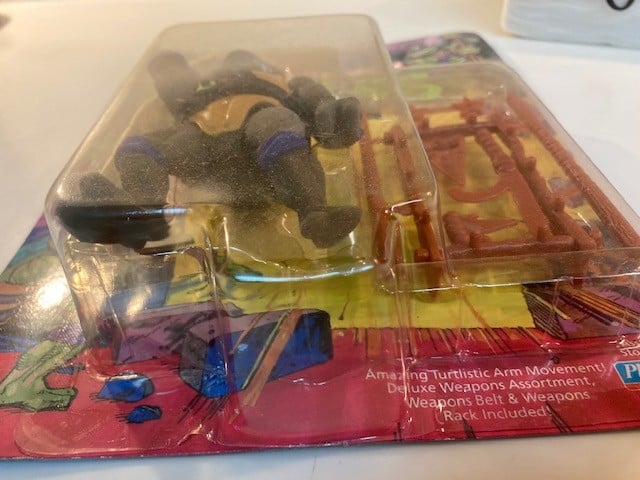
Sometimes, there is nothing that you can do to prevent blemishes on the plastic of your toys. For some blister packs, especially Teenage Mutant Ninja Turtles, the inside plastic often becomes stained and dirty. This likely originates from some dirt, exposure to heat, or other elements at the factory. However, the likelihood of seeing this sort of damage increases exponentially if the toys are stored in an attic or other area with extreme temperature fluctuations. While owners can attempt to prevent clouding and spots on the packaging’s plastic, it may wind up being an element fully out of their control.
The figure and its accessories
The final important factor is the action figure and its accessories. As with the other categories, grading services will closely examine the toy for damage from exposure and defects from the factory. So, there are many important factors to keep an eye out for.
As mentioned earlier, some toy lines are prone to falling apart thanks to O-Rings, gold plastic, and other parts. So, collectors should examine the figure from all angles to confirm that it is pristine.
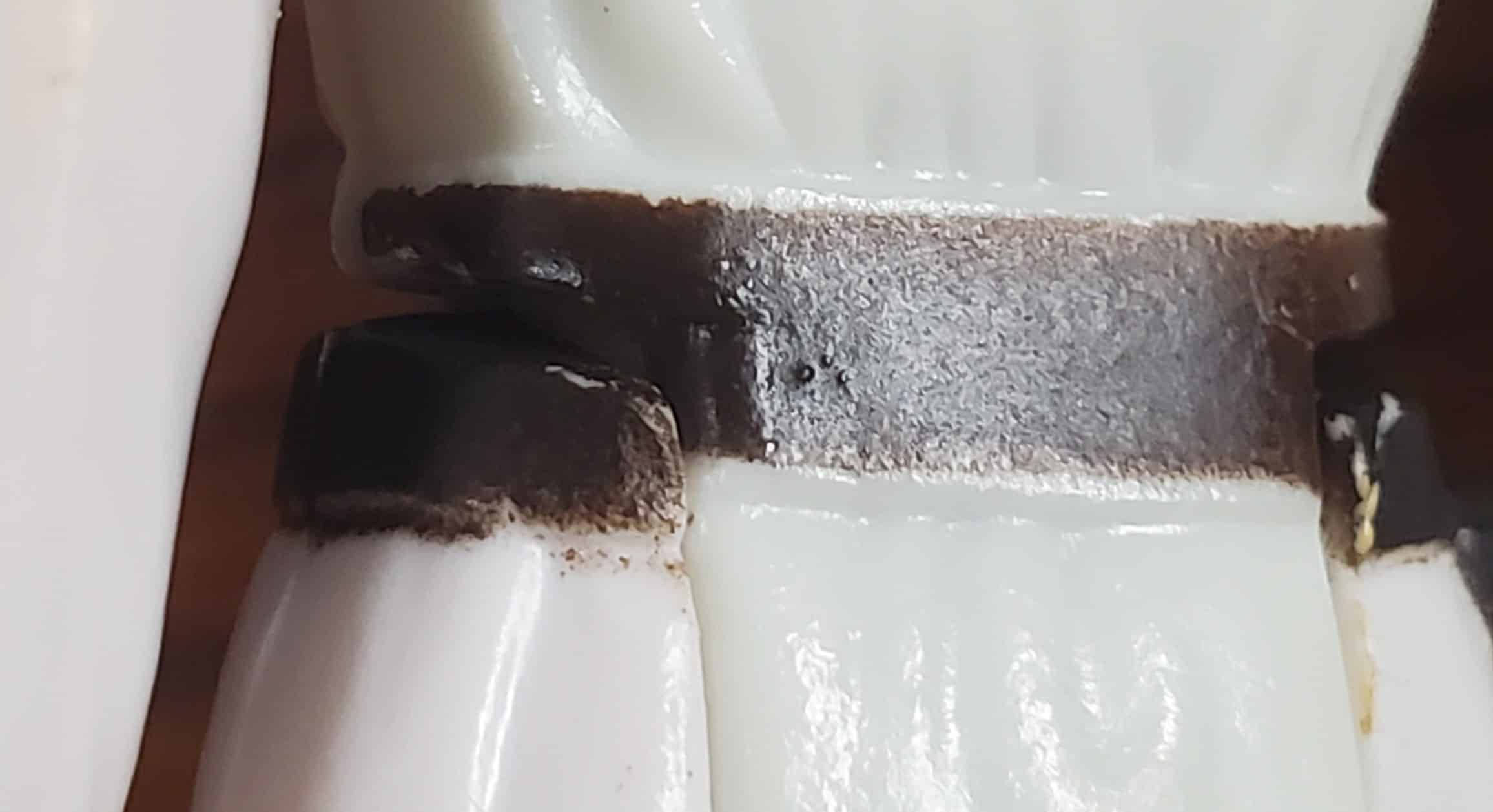
The paint job of the figure should also be considered and closely examined. While factories employ masks to create a generally uniform paint job on all mass-produced action figures, they are not always applied evenly. With the speed that these toys are produced, some figures received rushed, sloppy paint jobs. Even machine-applied paint jobs are not safe from masking and other errors.
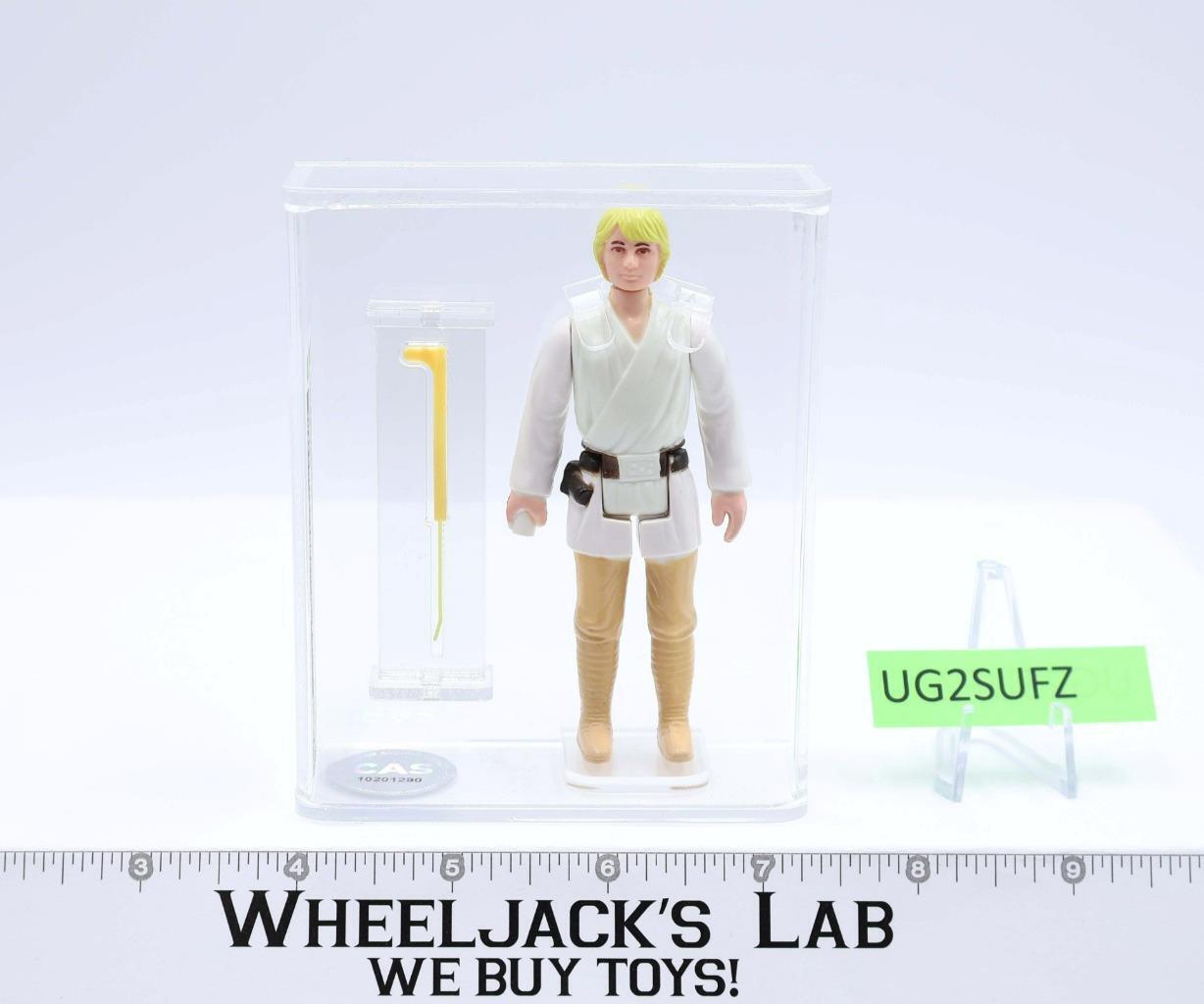
Many collectors forget to inspect the accessories before submitting them for grading. Unfortunately, damage, chips, and bad paint jobs on the accessories will reduce the overall grade of the action figure. Even a chip on a gun to an action figure can reduce the overall grade from a 90 to an 80. So, collectors must remember to examine the entire figure.
Another common oversight is the state of the plastic casing within the box or blister. Like the external plastic, this plastic can also deteriorate, fail, and yellow over time. This problem is very common in Star Wars, TMNT, and other toy lines. So, do not forget to examine all parts of the toy and its packaging.
The AFA/CGA and CAS can reject toys and other collectibles
Any owners that decide to skip the self-evaluation step and send toys to a grading service anyway might as well throw away money. Beyond risking the chance to receive a low grade which will not produce a return on investment, these owners risk additional fees if their toys are rejected.
Grading services may refuse to grade items that are badly damaged, yellowed, previously opened, or otherwise unfit. However, there are chances for opened, loose, and yellowed figures to receive a grade. As mentioned earlier, opened boxes with all parts present will receive a qualified grade. They also have a special category for yellowed plastic, “Y”.
Unfortunately, damage that occurs from shipping to the AFA/CGA, CAS, or other services possibly could lead to lower grades or disqualification. While owners can lower the risk of damage by carefully packing the toy, there is never a sure guarantee. If the shipping service throws around the figure’s box and causes damage, the owner will not only lose out on a valuable grade, but the figure will lose value in general.
Beyond being charged for the rejection, the owners of these figures will also be expected to pay the return shipping charges. So, it is crucial to take time and properly pick a toy for grading.
The majority of toys sent in for grading do not make the grade
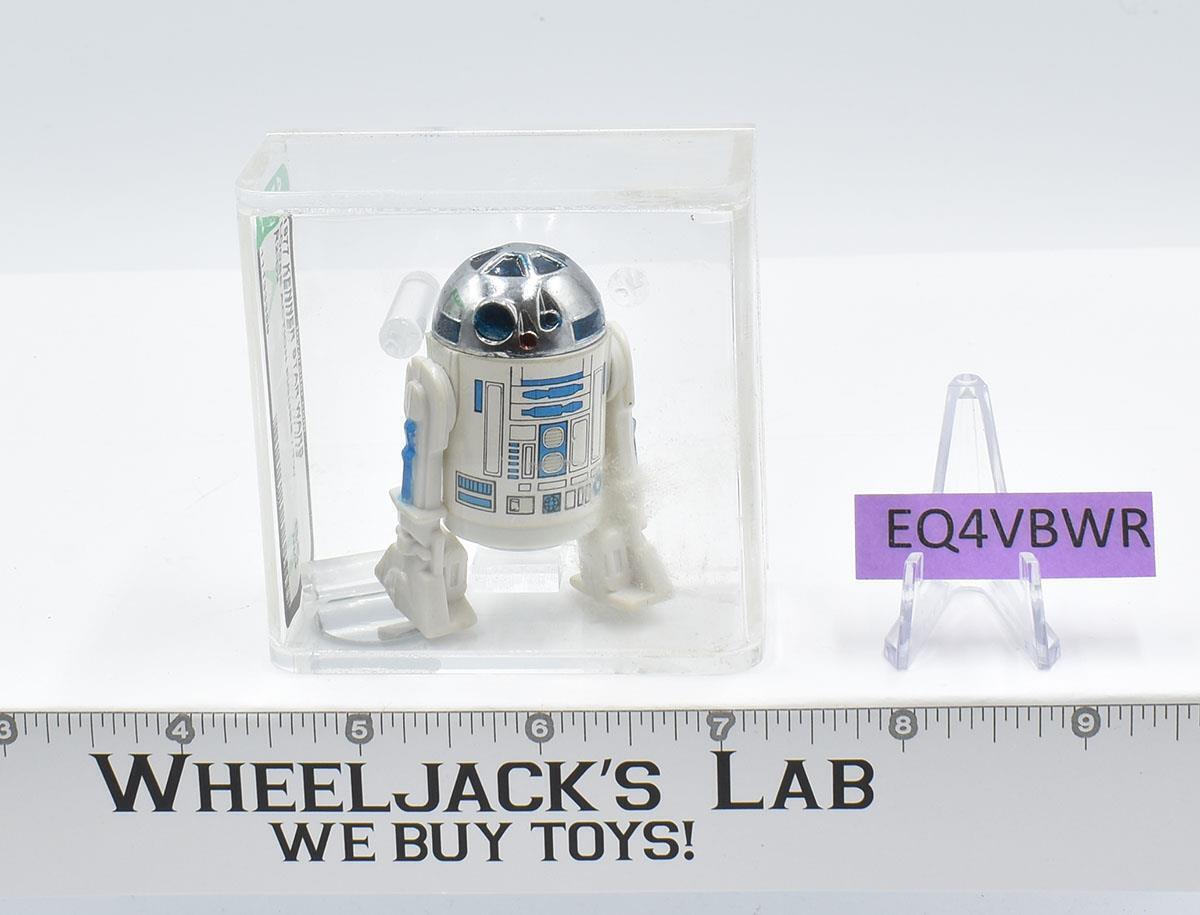
The short and simple of it is that the mass majority of toys, whether they are sealed or not, are not worth grading. While loose graded toys exist, they will never command the same price as a sealed vintage toy. Meanwhile, even most sealed toys from the 70s and 80s have not survived the decades without significant damage. While newer toys will inevitably look better since there has been less time for them to receive damage and deterioration. The downside to these newer toys is that they would not gain a large enough jump in value to make the grade worth it.
If you happen to be one of the lucky few with a toy that is both old enough, in excellent condition, and from a sought-after toy line, then you are golden. You may want to consider getting your toy graded with one of the professional services. However, there is one last factor that needs consideration.
Even a graded toy can lose value
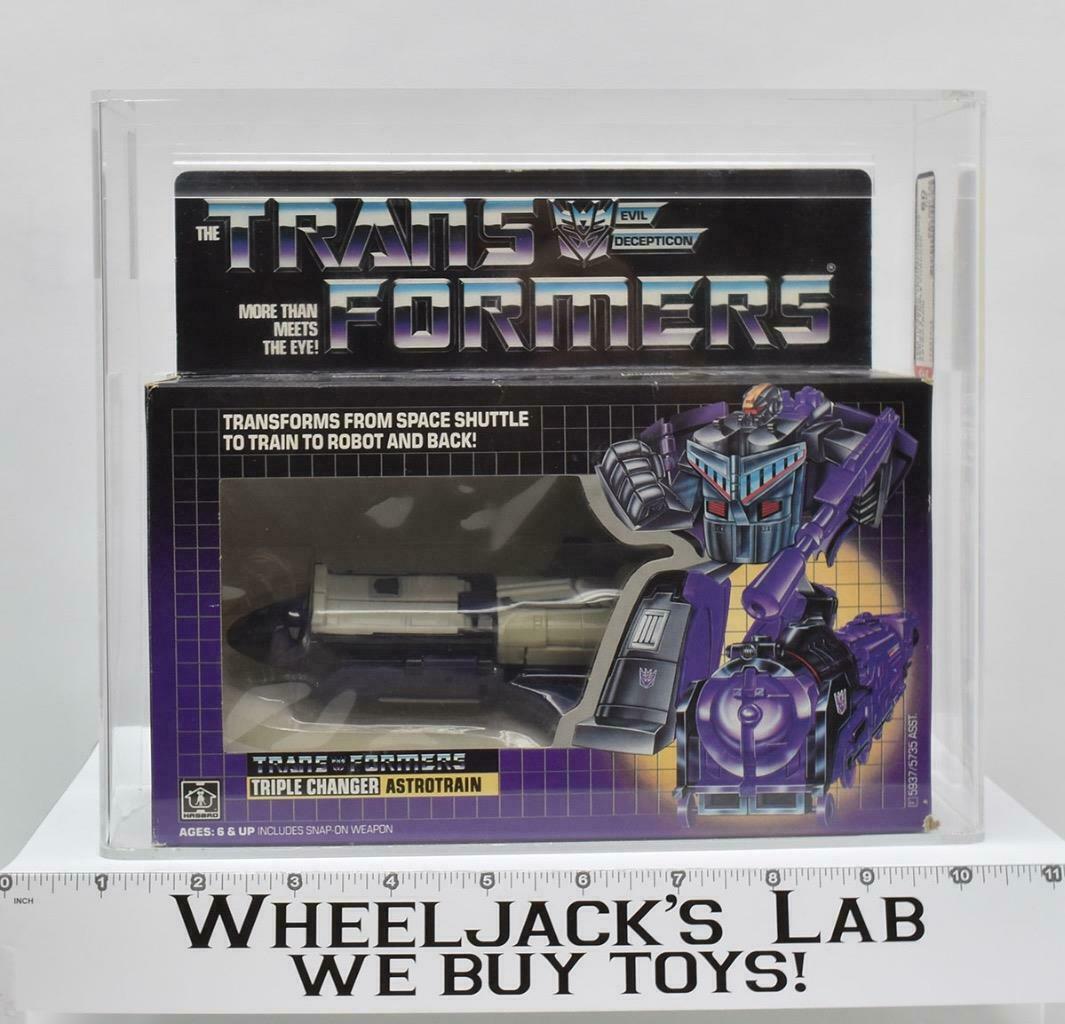
Despite passing the grade and making it to the AFA/CGA, CAS, or another service with no damage from shipping, a valuable collectible may not maintain the boosted value that a grade provides. If any damage occurs to the toy or even the acrylic casing on the return trip, the toy will lose value. This remains true even after it returns to its origin.
Some collectors have improperly stored graded toys, assuming that the acrylic case would protect them from all damage. The standard does little to negate damage from light, so owners should still be careful about exposure. If a collector wants to display their graded toys in lit areas, “Archival” quality cases are available at a premium. These cases are sturdier and provide UV light protection.
Unfortunately, some collectors do not realize that the condition of the case affects the value of their toys. If the case becomes cracked, chipped, scuffed, or otherwise damaged, the damage will affect the overall value of the collectible.
So, owners must be careful when transporting, storing, displaying, and otherwise owning their graded toys. Every small bit of additional damage will negate the value of the professional grading. If the worst happens and the case becomes damaged, grading services offer the opinion to recase graded toys, usually for a fee.
Alternatives to a professional grade
While it is true that most figures are not good candidates for grading, collectors can still take steps to protect their toys. One of the greatest investments for sealed toys is an acrylic case. Many companies sell a large variety of acrylic cases and protective clamshells that will help preserve collectibles. The most popular type of case is a sliding acrylic case.
Depending on the manufacturer, collectors can invest in the right protective case that suits their needs. Some of these cases even have UV coating to protect toys from light exposure. Others are thicker to provide even more protection.
One of the benefits of buying a case instead of grading is that collectors can avoid the risks involved with shipping. Instead, they can keep their toys secure in their homes. However, they will also need to case and secure their toys themselves.
AFA/CGA, CAS, or other graded toys can be a great investment
If a collector has considered all the variables that can affect the grading and value of their toys, they may enjoy a great boost in value from a graded toy. Those lucky few who manage to have the right toy with a professional grade can see considerable boosts in value. While there are many reasons to not send in the majority of action figures, vehicles, toys, and other collectibles to a service like the AFA, it can also be a great idea for the few rare toys. Still, we strongly encourage those both new and old to toy grading carefully consider the risks involved with submiting their toys to these services.
Do you have old and used graded toys?
If you have a collection of old and used toys, you can turn those toys into cash. There is no reason to let those old toys collect dust. Contact us today to sell your AFA/CGA, CAS, or other graded toy collection.
Our professional, friendly, and expert staff have decades of experience as collectible toy buyers. If you are ready to sell your collection today, fill out the form below or call us at 888-946-2895.
About the Author
Chris Ingledue is the founder and owner of Wheeljack’s Lab pop Culture and Toy Shop. His vision has always been to reunite customers with their favorite childhood toys and pop culture, triggering fond memories, and reigniting their imaginations. Every day he works in the “lab” where it’s Christmas 365 days a year; scouring the internet – like we did the Sears Catalog of yesteryear – for the next great treasure, awaiting the arrival of the postman as if he was Santa Claus himself and helping collectors worldwide with their own versions of Christmas. For Chris, every day as a vintage toy buyer is an absolute joy!